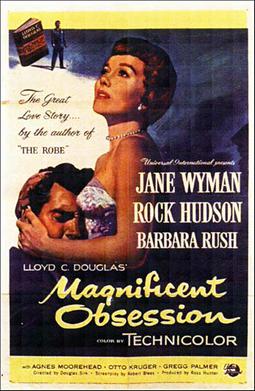 |
| Lauren Bacall, Rock Hudson, and Robert Stack in Written on the Wind |
Lucy Moore Hadley: Lauren Bacall
Kyle Hadley: Robert Stack
Marylee Hadley: Dorothy Malone
Jasper Hadley: Robert Keith
Dan Willis: Robert J. Wilke
Biff Miley: Grant Williams
Dr. Cochrane: Edward Platt
Director: Douglas Sirk
Screenplay: George Zuckerman
Based on a novel by Robert Wilder
Cinematography: Russell Metty
Art direction: Robert Clatworthy, Alexander Golitzen
Set decoration: Russell A. Gausman, Julia Heron
Film editing: Russell F. Schoengarth
Costumes: Bill Thomas
Music: Frank Skinner
In All That Heaven Allows (1955) and Imitation of Life (1959), Douglas Sirk demonstrated his unsurpassed skill with the "woman's picture," centered on the problems women face in trying to conform to society's demands. But in Written on the Wind, Sirk delivered an essential twist on the genre: a woman's picture about men. There may be no keener exploration of impotence than this portrait of the inability of Rock Hudson's Mitch Wayne and Robert Stack's Kyle Hadley to live up to the concept of masculinity. Kyle is the more obvious example of the problem: He is so terrified that he's sterile that when his wife, Lucy, becomes pregnant, he turns on Mitch, his best friend, accusing him of impregnating her. Granted, he's tricked into this by his malicious sister, Marylee (Dorothy Malone), who is taking her revenge on Mitch for spurning her advances. But this also brings into focus Mitch's problem: Everyone -- Marylee, Lucy, and, yes, Kyle -- is in love with him, and he can't satisfy all of them and remain true to himself. He has been set up by Kyle's father (Robert Keith) as a kind of model of masculinity -- a rags-to-riches success story -- so Kyle, who has never known anything but riches, both admires and resents him. No wonder Mitch wants to escape from the turmoil of the Hadley household and go to work in Iran. Seething under all of this psychodrama is a subtext we now know in greater detail: Hudson's secret life as a gay man. It's reasonably sure that Sirk, who boosted Hudson's career, elevating him into a major star, knew about the actor's off-screen life, so Written on the Wind has grown in stature over the years as one of those films in which a star's personal life deepens a character's backstory. As usual, Sirk and cinematographer Russell Metty provide a rich Technicolor environment for the story, with a masterly use of visually metaphoric shadows and (as in the still above) reflections. Sirk also made the most of the Universal art department, crafting a milieu of excess and sometimes dubious taste for the Hadleys: Notice the array of bottles and geegaws on the dresser in that image. And Bill Thomas's costuming, including some retina-burning reds and oranges for bad girl Marylee, contrasting with muted tones for good girl Lucy, is almost eloquent in what it says about the characters. Written on the Wind is usually cited as a precursor of those 1980s prime-time soaps about the superrich, Dallas and Dynasty, but Sirk gives it more edge and wit than they ever showed.





